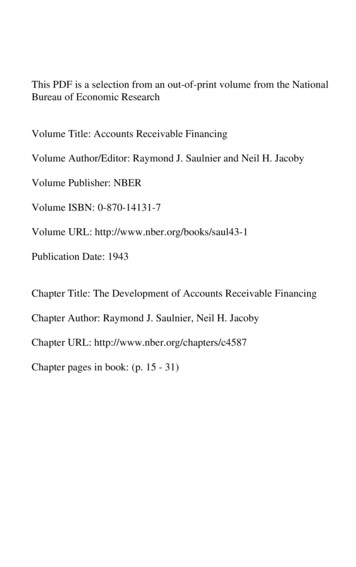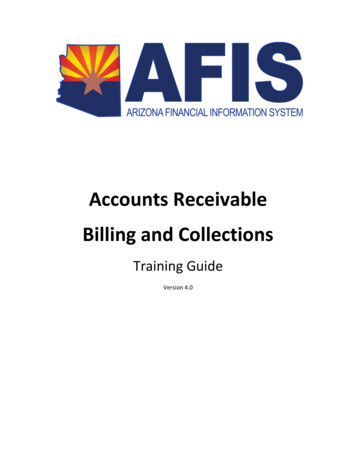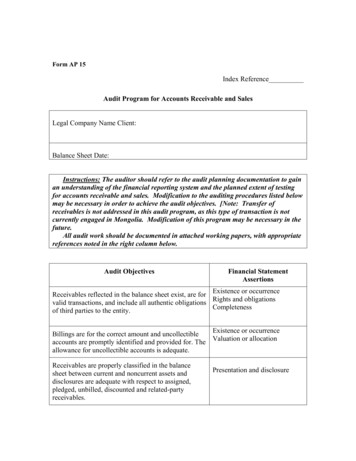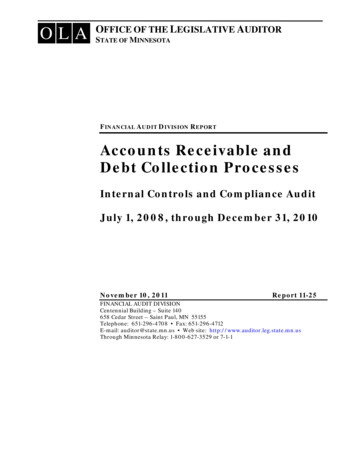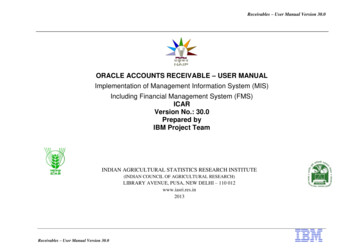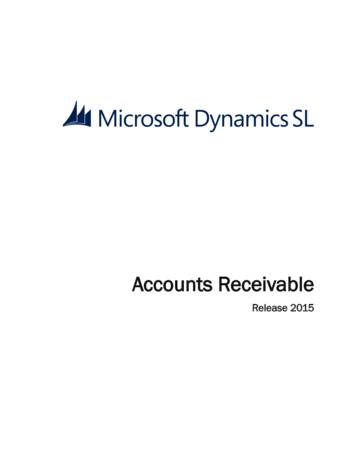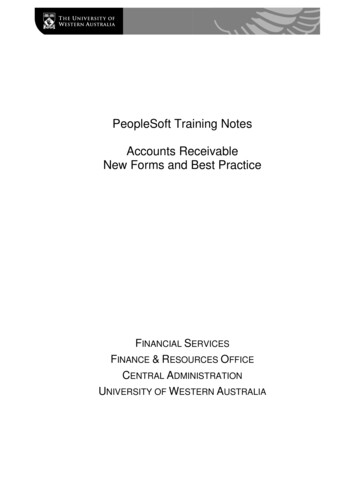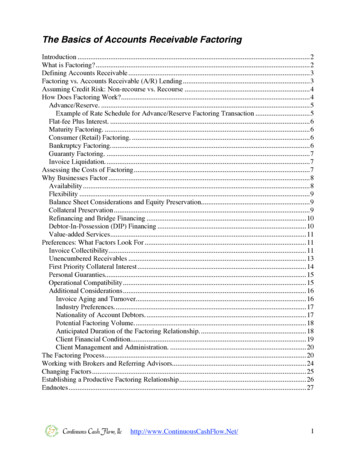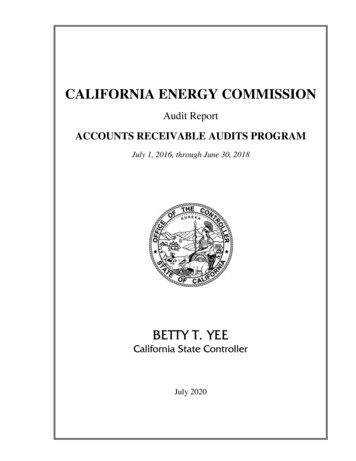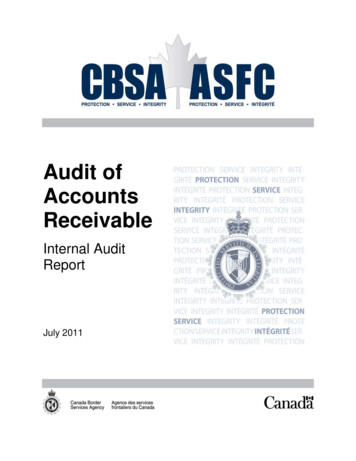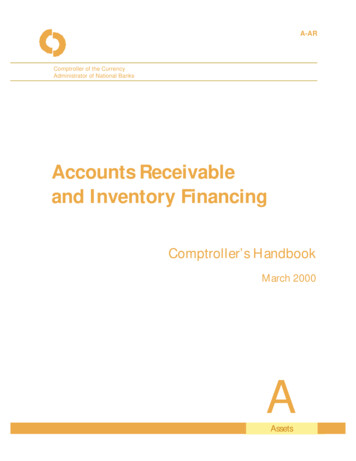
Transcription
A-ARComptroller of the CurrencyAdministrator of National BanksAccounts Receivableand Inventory FinancingComptroller’s HandbookMarch 2000AAssets
Accounts Receivableand Inventory FinancingTable of ContentsIntroductionOverviewRisks of Accounts Receivable and Inventory FinancingCredit Risk Rating ConsiderationsTypes of Accounts Receivable and Inventory FinancingAccounts Receivable and Inventory Financing StructuresRevolving Credit“Permanent” Working CapitalSeasonal Operating AdvancesOver-advancesTerm DebtEvaluating the BorrowerAssessing the Borrower’s Financial PositionAssessing the Borrower’s Operating CycleAssessing the Borrower’s IndustryAssessing the Borrower’s Management TeamEvaluating CollateralAccounts ReceivableInventoryUnderwriting ARIF LoansCollateral Controls in the Loan AgreementDocumentationFinancial CovenantsThird-Party Guarantees or InsurancePricingAdministering ARIF LoansDisbursing Revolving Loan AdvancesMonitoring SystemsSpecialty Financing ArrangementsStructured FinanceDebtor-in-possession FinancingFactoringThird-Party VendorsComptroller’s 2728283131323334Accounts Receivable and Inventory Financing
Compliance IssuesDebt Liquidation and Lender LiabilityState and Federal Laws, Rules, and RegulationsAllowance for Loan and Lease Losses35353536Examination ProceduresGeneral ProceduresQuantity of RiskQuality of Risk ManagementConclusions3737404956AppendixesA. ARIF Summary ChartB. Trade Cycle Analysis WorksheetC. Adverse Risk Rating Examples58585960Glossary69References75Accounts Receivable and Inventory FinancingiiComptroller’s Handbook
Accounts Receivableand Inventory FinancingIntroductionThis booklet describes the fundamentals of accounts receivable and inventoryfinancing (ARIF). The booklet summarizes ARIF risks and discusses how a bankcan prudently manage these risks. One of a series of specialized lendingbooklets of the Comptroller’s Handbook, “Accounts Receivable and InventoryFinancing” supplements the general guidance in the “Loan PortfolioManagement” and “Commercial Lending” booklets.OverviewARIF is the most fundamental form of “collateral-based” commercial lending. Itcombines elements of secured lending and short-term business loans. In itspurest form, commercial borrowers use the value of their receivables andinventory (working assets) as collateral to secure financing to produce andmarket their products and services. The financing is then repaid by convertingthe inventory to cash, either directly or through the collection of an accountsreceivable invoice. Depending on the risk profile of the borrower, lendersexercise varying degrees of control over collateral to manage the credit risk inthe transaction.Over time many variations of ARIF have developed. The collateral base maynow include assets other than receivables and inventory, controls overcollateral have been modified, and repayment sources have been expandedbeyond the conversion of working assets. In addition to providing funds tofinance inventory, ARIF loans are used to finance acquisitions, to restructuredebt, and to tide companies through periods of distress. Manufacturers,wholesalers, distributors, retailers, importers and service organizations all useARIF to meet their business needs. Although ARIF has undergone change, itremains essentially a means for borrowers to leverage assets to obtainfinancing.As the structure of ARIF loans has been modified, the availability of ARIF hasalso expanded. Once the province of a small group of specialized lenders,ARIF is now offered by most large and mid-sized banks and many communitybanks. Borrower demand for more credit availability and banks seekingopportunities to expand their loan portfolios have spurred this growth.However, as discussed below, this type of specialized lending carries with it ahigher degree of risk than most other types of commercial lending. As a result,Comptroller’s Handbook1Accounts Receivable and Inventory Financing
ARIF loans require more intensive controls and supervision. ARIF has severalunique features. Most particularly, the source of repayment of these loans isdedicated cash flows from the conversion of working assets, unlike mostcommercial loans where the source repayment is cash flow from operations.(For a more compete discussion of cash flows, see the section below on“Assessing the Borrower’s Operating Cycle.”) The controls applied to collateraland cash receipts also differentiate ARIF loans from other types of commercialloans.Most ARIF relationships exhibit moderate to high risk. Borrowers typicallyturn to ARIF when they cannot obtain other types of financing. ARIF borrowersmay not be as strong financially as other commercial borrowers, they mayoperate in industries with high volatility or significant seasonality, or they maybe experiencing rapid growth. These borrowers exhibit higher risk of defaultcharacteristics such as:CHigh leverage.CErratic or marginal profitability.CLimited working capital and cash reserves.CConstantly changing collateral pools whose value can fall quickly.Properly structured ARIF transactions mitigate the risk of default by imposingcontrols on collateral and cash. When an ARIF loan is properly margined andthe bank applies prudent monitoring and control processes, the risk of lossactually can be less than for other types of commercial lending. The key is inexercising the degree of control necessary to manage and mitigate the risks —the higher the risk, the greater the control needed. To achieve control, lendersneed significant management expertise, a thorough understanding of theborrower’s business, good reporting systems, and ongoing supervision of thecollateral and the relationship.Because of the higher intrinsic default risk in ARIF loans, ARIF units oftenreport higher levels of adversely rated loans than other commercial lendingunits. This is expected. By the same token, the collateral support andadministrative controls used to manage these loans, particularly in wellmanaged ABL units, often results in lower losses. The lower loss experienceshould be reflected in the allowance provision and in capital allocations ininternal risk models.Accounts Receivable and Inventory Financing2Comptroller’s Handbook
Risks of Accounts Receivable and Inventory FinancingFrom a supervisory perspective, risk is the potential that events, expected orunanticipated, may have an adverse impact on a bank’s capital or earnings. TheOCC has identified nine categories of risk for bank supervision purposes:credit, interest rate, liquidity, price, foreign currency translation, transaction,compliance, strategic, and reputation. While ARIF has all these risks, thisbooklet will focus on credit, transaction, and compliance risk. For a completediscussion of the other risks, refer to the “Loan Portfolio Management” bookletand the Comptroller’s Handbook for National Bank Examiners.Credit RiskCredit risk is the current and prospective risk to earnings or capital arising froman obligor’s failure to meet the terms of any contract with the bank orotherwise to perform as agreed. Credit risk arises any time bank funds areextended, committed, invested, or otherwise exposed through actual or impliedcontractual agreements, whether reflected on or off the balance sheet.Like other types of commercial lending, ARIF’s most significant risk is creditrisk. ARIF borrowers typically exhibit higher default risk than other commercialborrowers. Credit risk is present in every part of the lending cycle — initialcredit evaluation, underwriting, loan approval, loan administration, and, ifnecessary, debt liquidation.Transaction RiskTransaction risk is the current and prospective risk to earnings and capitalarising from fraud, error, and the inability to deliver products or services,maintain a competitive position, and manage information. ARIF has elevatedtransaction risk because of the complexity of the products and the internalcontrol environment. The risk encompasses product development and delivery,transaction processing, systems development, computing systems, employeeintegrity, and operating processes. Transaction risk can also develop whenmanagement or staff does not provide sufficient oversight.Transaction risk in accounts receivable and inventory financing is primarilyposed by: Internal operations of the lending department, including the need to properlyperfect liens under the Uniform Commercial Code (UCC). Internal operations of the borrower.Comptroller’s Handbook3Accounts Receivable and Inventory Financing
The potential for fraud on the part of the borrower. The failure to properly oversee ARIF computer software products offered bythird-party vendors, if applicable.Compliance RiskCompliance risk is the risk to earnings or capital arising from violations of ornonconformance with laws, rules, regulations, prescribed practices, or ethicalstandards. Compliance risk also arises in situations where the laws or rulesgoverning certain bank products or the activities of the bank’s clients may beambiguous or untested. Because ARIF departments exert a significant amountof control over the borrower’s working assets, this type of lending can be morevulnerable to compliance risk. This booklet discusses compliance risk posedby: Noncompliance with federal and state laws, rules, and regulations. Forexample, a borrower may suffer financial setbacks if it violates or fails toconform to laws governing environmental contamination, health, safety, orfair labor. Litigation and other legal remedies (for example, lender liability actions) thatmay arise when the lender seeks to have a debt liquidated.Credit Risk Rating ConsiderationsConsiderable debate has surrounded the issue of whether the uniform interagency classification guidelines are appropriate for rating ARIF loans. OCCpolicy is to apply the uniform interagency rating definitions, as contained in the“Classification of Credits” section of the Comptroller’s Handbook. Thesedefinitions take into account both risk of default and risk of loss in the event ofdefault. Risk of default is generally a matter of the financial strength of theborrower, while risk of loss upon default is generally a matter of the quality ofunderwriting (terms, collateral, covenants, etc.).When applying the credit rating definitions to individual loans, examinersshould remember that ARIF is a type of secured lending. Decisions on riskratings must take into account whether sources of repayment will producesufficient cash flow to service the debt as structured, collateral value, andcollateral liquidity. Any laxity in the bank’s monitoring and control of thecollateral can diminish the protections afforded by collateral and lower a loan’sAccounts Receivable and Inventory Financing4Comptroller’s Handbook
risk rating. Inappropriate structure can also be a significant factor in assigningan adverse risk rating.Borrowers whose loans are administered in dedicated ARIF units, particularlyasset-based lending1 (ABL) units, often have high leverage and/or erraticearnings or losses. These characteristics are often the norm for ARIFborrowers; their presence does not necessarily warrant an adverse risk rating,but may do so if conditions deteriorate further.More pertinent to the loan’s rating is comparison of the borrower’s actualperformance with what was expected when the loan was underwritten. If theborrower repeatedly fails to meet earnings projections, has a trend of heavylosses or excessive leverage, needs internally approved over-advances toofrequently or for too long, fails to provide timely financial information(including inventory and receivable aging information) fails to perform onrelated debt, or unexpectedly needs to access debt outside the ARIF line, theloan is a candidate for an adverse risk rating. An adverse rating may also beappropriate if the bank must adjust advance rates or change definitions ofeligibility, including the addition of fixed assets to the borrowing base, to keepthe loan within formula (see glossary). If liquidation of collateral (e.g., a forcedsale by the bank or borrower), is an ARIF loan’s most likely source ofrepayment, the loan would normally be classified as substandard at best.Some industry participants contend that ARIF loans, especially thoseadministered in well-controlled ABL units, should be assigned a more favorablerisk rating than a loan with similar earnings and balance sheet characteristicsbecause of the existence of collateral and the dedicated staff’s oversight. Such ablanket system of applying risk ratings is not appropriate — in the same waythat it is not appropriate to assign an adverse risk rating simply because an ARIFborrower has low or deficit net worth or occasional losses. While propercontrols help to moderate the risk of asset-based lending, they do not bythemselves overcome well-defined credit weaknesses.Additional guidance on risk rating ARIF loans is provided in appendix C, whichincludes examples of adversely rated credits and the ratings’ rationale.1A specialized form of ARIF in which lenders exercise close control over credit availability andcollateral by setting a borrowing base, controlling cash receipts, and carrying out field audits.Comptroller’s Handbook5Accounts Receivable and Inventory Financing
Types of Accounts Receivables and Inventory FinancingBecause ARIF has many possible structures, the banking industry has manydifferent definitions. This booklet divides ARIF into four types based on thelevel of monitoring and control. Regardless of the specifics of each category,examiners should focus on whether the monitoring and controls are adequatefor the types of ARIF lending conducted by the bank. The four categories aredefined as follows:Asset-Based Lending (ABL) — A relationship in which lenders closely controlcredit availability and collateral. Asset-based lenders use a borrowing-baseformula (derived by multiplying the value of eligible collateral by an adv
Quality of Risk Management 49 Conclusions 56 Appendixes 58 A. ARIF Summary Chart 58 B. Trade Cycle Analysis Worksheet 59 . inventory (working assets) as collateral to secure financing to produce and market their products and services. The financing is then repaid by converting the inventory to cash, either directly or through the collection of an accounts receivable invoice. Depending on the .
